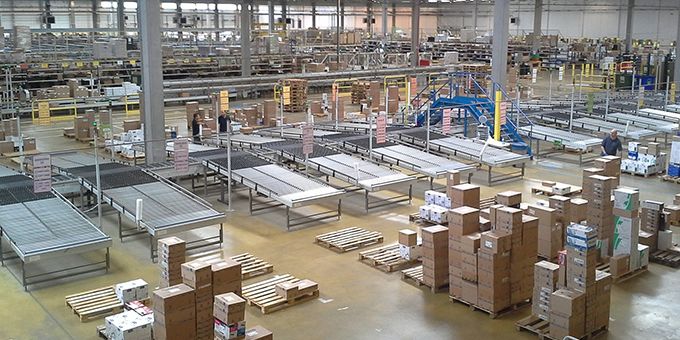Trouble often comes from the surfaces that warehouses, processing plants and other facilities use. Without the right surface material, bacteria can collect even with the right practices in place — raising the risk of food contamination.
 How Does Electropolishing Surfaces Keep Food Safe?
How Does Electropolishing Surfaces Keep Food Safe?

Megan Ray Nichols | Schooled by Science
Food safety remains a significant issue for the food and beverage industry. Every year, there are typically a few high-profile outbreaks of foodborne illness in the United States. Some of these recent outbreaks have been so severe that they prompted the Food and Drug Administration (FDA) and other regulatory bodies to tighten food safety standards.
Better practices throughout the manufacturing process and supply chain can reduce the risk of contamination. These include a first in/first out system, good temperature management and policies that promote traceability. However, trouble often comes from the surfaces that warehouses, processing plants and other facilities use. Without the right surface material, bacteria can collect even with the right practices in place — raising the risk of food contamination.
However, electropolishing — a metal finishing process used to create corrosion-resistant surfaces — can help keep food safe.
How Material Choice Can Contribute to Bacteria Buildup
Food will come into contact with dozens of surfaces as it makes its way through a food processing plant. Each moment of contact presents another opportunity for food contamination if the surface is unsuitable for food processing or difficult to clean.
Porous and rough surfaces with microscopic dents and crevices facilitate bacterial growth, which can contaminate food and cause illness. These crevices also make these surfaces harder to clean, increasing the presence of bacteria. Once microbes begin building up, they can become challenging to remove.
For this reason, facilities that process food need surfaces smooth enough to be free of crevices and cracks — as well as virtually poreless. These surfaces must also consist of a material that can handle extreme temperatures and stand up to the regular, intense sanitation processes of industrial food processing facilities.
Stainless steel is an industry-standard material, found in almost every facility that processes food. It's sturdy, corrosion-resistant, adaptable to high temperatures and easy to maintain — making it perfect for industrial settings.
Bacteria biofilms, however, can still build up on stainless steel surfaces over time — while the material is resistant to corrosion, it isn't immune. Most industrial facilities that handle food are highly corrosive environments. This characteristic is due to the chemical properties of different food items, chemical cleaning agents and the use of high-pressure water for cleaning. Without the right precautions, stainless steel surfaces in these facilities will degrade over time. If this corrosion is left unmanaged, it will increase the likelihood of food contamination.
However, facilities use several methods to prevent the corrosion of stainless steel surfaces.
Methods like passivation — which use chemical reactions to make stainless steel surfaces more corrosion-resistant — are popular for some applications. However, while passivation is appropriate for some steel surfaces, it can't be used to treat certain alloys and can't remove surface imperfections. As a result, industrial facilities will sometimes look to other methods, like electropolishing.
How Electropolishing Can Prevent Corrosion
Electropolishing uses a pair of electrodes and a chemical bath to remove a surface layer from the stainless steel object being polished. By removing a thin layer of the material, this process eliminates surface imperfections, product buildup, burrs and roughness, bringing the surface to a mirror finish. It can create the smoothest possible finish for stainless steel. This finish level can otherwise only be achieved with the use of progressively finer abrasives or extensive buffing.
Electropolishing is sometimes called "reverse plating" because it creates a corrosion-resistant surface by removing surface material. This technique is a contrast to plating techniques like electroplating and passivation, which apply a protective layer to the surface of stainless steel objects.
The smoother surface that electropolishing creates makes the object easier to clean. Lower surface roughness decreases the pressure needed to clean stainless steel surfaces and makes it easy for cleansing products to reach the bacteria growing on the steel surface. A finely polished surface can also reduce the adhesion of sticky substances, making it easy to remove food residue from electropolished steel.
Electropolishing can also be used to polish any stainless steel object, regardless of shape or size.
What Are the Advantages of Electropolishing Over Other Steel Finishing Methods?
Mechanical polishing methods can also yield surfaces appropriate for food production facilities — but not all of them can provide the high level of smoothness necessary. Several trade associations and non-governmental organizations, like the American Meat Institute (AMI) and European Hygienic Engineering Design Group (EHEDG), recommend a maximum roughness rating of 0.8 micrometers for stainless steel surfaces in food processing facilities. Electropolishing can polish steel surfaces to a maximum roughness of around 0.8 micrometers.
Choosing electropolishing rather than a corrosion-prevention technique like passivation can also ensure better fatigue performance of treated surfaces.
Electropolishing tends to yield a more aesthetically pleasing surface than other polishing methods. The electropolishing process can remove the dullness and discoloration on stainless steel caused by corrosion and exposure to extreme heat. It also won't leave fine directional lines or a non-uniform finish, which can sometimes be caused by mechanical polishing.
Improving Food Safety With Electropolished Stainless Steel
For facilities that want to ensure food safety, choosing the right finishing technique will be essential. Plating techniques like passivation will work in certain scenarios, but may not be usable depending on the alloy of the steel object that needs finishing. Electropolishing addresses the major finishing needs of food processing plants. This method removes surface imperfections, burrs and roughness that can harbor bacteria and make steel surfaces harder to clean.
Electropolishing also provides an extremely smooth finish that mechanical polishing methods can struggle to match. For food processing factories wanting to minimize the risk of bacterial growth, electropolishing will be one of the best finishing methods available.
The content & opinions in this article are the author’s and do not necessarily represent the views of ManufacturingTomorrow
Comments (0)
This post does not have any comments. Be the first to leave a comment below.
Featured Product

